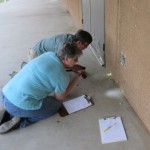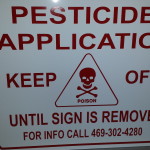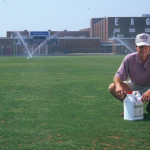Spring ISD earns recertification for integrated pest management practices By: Paul Schattenberg
Spring Independent School District has once again earned IPM Star certification for its sustainable pest management practices.

Janet Hurley, foreground, and Hoa Phan, Spring ISD, IPM coordinator investigate building for ants, image courtesy of Tom Green, IPM Institute of North America
The school district was given an intense inspection of its sustainable pest control practices by experienced integrated pest management professionals, said Janet Hurley, Texas A&M AgriLife Extension Service school integrated pest management specialist who served as one of the evaluators.
“The IPM STAR program of the IPM Institute of North America evaluates school systems and childcare centers for their adherence to sustainable and environmentally responsible pest management practices,” Hurley said.
Dr. Thomas Green of Madison, Wisconsin, an entomologist who directs the institute, served as the other evaluator.
“We did a careful on-site evaluation of Spring ISD’s integrated pest management program using a quantitative, practical evaluation specific to the organization for measuring performance,” Hurley said. “We found that they met or exceeded the high standards for sustainable IPM practices.”
Hurley said proper integrated pest management reduces liability and risks from both pests and pesticides and that IPM Star certification is a voluntary action that shows an organization’s pest management practices are highly competent and efficient.
“Among other things, to achieve this certification Spring ISD had to establish a formal schedule for IPM evaluation, planning and training as well as develop an ongoing focus on pest and pesticide risk reduction to ensure they met these high standards,” she said.
Hurley said integrated pest management focuses on non-chemical methods of control such as sealing, sanitation and monitoring.
“Pesticides are categorized by the state as red, yellow and green products, with green being the lowest-risk category,” she explained. “Prior to implementing the IPM program, Spring ISD employed a combination of these three groups of products, but used less than 50 percent green products. However, since the 2011-2012 school year, they have been using 100 percent green products.”
“Spring is a great example of how trained individuals, focusing on eliminating pests’ access to food and shelter, can achieve excellent pest control,” added Green. “Everyone at Spring understands their roles in keeping pests out – from the custodians to the maintenance and food service professionals who all work hard to eliminate pest-friendly conditions with proper cleaning and maintenance.”
Dr. Frederick Walker, director of operations for Spring ISD, said achieving recertification was a team effort.
“We get great support from our staff and administrators,” Walker said. “We let them know what we’re doing and that we’re following a process and monitoring and recording the results on a regular basis. We also meet with parent groups to explain our process and the use of green chemicals for pest management, especially if they will be using them in the concession areas.
“And although we could use more people to help, the two applicators we have currently are doing an excellent job of covering every one of the schools in the district. But I guess what we’re most proud of is that, in the several years we’ve been implementing these IPM practices, we have not disrupted the educational experience of a single child in the district.”
Hurley will attend a Spring ISD school board meeting to make a presentation acknowledging the district’s recertification.
Changes in the rules of the game for Texas PMPs – By Mike Merchant
New rules governing the pest control industry in Texas were published last week and are now in effect. While none of the changes in the “rules of the game” are major, there may be a few things that affect your business or school district.
The rules governing pesticide use in Texas can be complicated, and are passed down to us through two sets of documents. First, the Texas Occupations Code (TOC) contains the official list of laws as passed by the legislature pertaining to different occupations, including structural pest control. If you go to this code online, the chapter having to do with pest control is Chapter 1951. Chapter 1951 lists all the state law as passed over the decades that relate to the business of structural pest control.
The second and probably most relevant set of rules to our industry is the Texas Administrative Code (TAC). The TAC records how the various state agencies choose to interpret and administer the laws. For example, Section 1951.212 of the TOC directs the Texas Department of Agriculture to establish standards for an IPM program for public school districts. The TAC Sections 7.201-7.205 spell out what the standards are, including requirements for IPM coordinators, pesticide categories, posting requirements, etc.
But wait a minute. How can non-elected bureaucrats in a state agency write rules outside the legislative process? The answer is that legislators don’t have the time or the expertise to write detailed regulations, so they pass their rule-making authority on to Executive branch agencies like the Department of Agriculture. Of course the rules have to fairly interpret the law, and they must be published ahead of time in the Texas Register so that all of us can review and comment.
Publication of several new or revised sections of Subchapter H of the TAC (Texas Department of Agriculture) marks the end of this process for pest control rules this year. On December 18 the Texas Register published the results of public comment and listed the final versions of proposed rules originally published on September 18. With this final version, the rules are now considered to be in effect.
Most of the changes were made simply to clarify wording of the old rules. There was also some reorganization of section numbering, so that old rule citations may no longer apply. Here are the essential changes:
- Sec. 7.122 Changes in wording that include giving power to the Department to deny a license to anyone who holds a similar license that has been revoked, suspended, probated or denied within the last five years by another state or by the federal government.
- Sec. 17.127 There are no more fees for providing a continuing education course.
- Sec. 7.141 Rewording of rules pertaining to ID that must be carried at all times by license holders. Basically, if you have a license you must carry it on your person at all times and show it to any customer or relevant government employee who asks. If it’s not legible, then its not a legal ID. Also, language on vehicle signage has slightly changed to require all marked or unmarked vehicles being used for customer contact or service must have the business license number prominently displayed (magnetic signs are not OK).
- New Sec. 7.150 requires all pesticides be used consistent with the pesticide labeling, and prohibits use of any pesticide missing a complete label when the identity of that pesticide is unknown.
- New Sec. 7.151 prohibits anyone from hurting people or the environment, and making the pesticide owner, the applicator and/or the mixer equally responsible for proper storage and disposal of pesticide containers and contents. It also requires all pesticide containers to be labeled with the name of the pesticide. And it specifies that hard copies of all pesticides being stored shall be available for inspectors visiting the storage site.
- Sec. 7.152 states that no one may advertise to perform structural pest control services without a license, and that all advertising must include the same business name as is on the license. This rule was rewritten to ensure that companies not use multiple business names under the same business license, and to clarify that pest control advertising includes online ads such as might appear on sites like Facebook, Craigslist and Angie’s List.
- Sec. 7.193 is a new section number which clarifies who may qualify as a member of the Structural Pest Control Advisory Committee from an institution of higher learning (the position I formerly held, and now is being held by Dr. Robert Puckett).
- Sections rules for the IPM program for public school districts have been moved to a new Division (7) and renumbered from Sec. 7.150-7.154 to 7.201-7.205. The biggest changes in this section relate to CEU requirements for IPM Coordinators.
- Sec. 7.202 School IPM coordinators no longer are specifically required by rule to personally conduct periodic inspections of their school district. While this remains desirable, taking away this rule frees the coordinator to rely on other trained inspectors to provide inspection reports.
- Sec. 7.204 includes slight wording changes to clarify that outdoor areas treated with a pesticide may be posted

Remember TX school IPM rules require that you post at the time of treatment and keep in place until the specified reentry has been reached.
at all entry points with a sign in lieu of a lock, fence or barrier tape until the reentry time is over. This section also allows IPM Coordinators, or their supervised employees, to use non-pesticide containing monitoring devices like sticky traps, to monitor pests without a license.
Perhaps the most significant change heralded by these rules is that expanded CEU requirements for school IPM Coordinators (IPMCs) are now officially in place. Over four years ago, as a result of Sunset Commission recommendations, the legislature decided that ongoing CEUs would be required for school IPMCs. Until now, the only CEU requirement was that IPMCs have six hours of department-approved training at the beginning of their appointment. Under the new rule IPMCs must have six hours of verified, approved training every three years. While most of these CEU requirements can come from any approved, relevant pesticide CEU class, at least one of the hours must be related to school IPM rules and regulations. The countdown for existing IPMC’s three years will start this January, or for new IPMCs at the date whenever their initial training is completed. Pesticide CEUs obtained in support of a pesticide applicator’s license can be double-counted toward the CEU requirements for IPMCs.
Turfgrass short course to be offered in College Station Jan. 19-22 By: Kay Ledbetter
A four-day Turfgrass Ecology and Management Short Course presented by the Texas A&M AgriLife Extension Service will be held Jan. 19-22 on the Texas A&M University campus in College Station.
Dr. Casey Reynolds, AgriLife Extension turfgrass specialist in College Station, will present the educational workshop for anyone interested in the fundamentals of turfgrass physiology and management.
“This course is designed for professional turfgrass managers as well as anyone else in the green industry with a desire to learn the basics of how to properly manage turfgrasses with respect to growth, fertility, pest control, water use and water quality,” Reynolds said.
During the training, attendees are exposed to the fundamentals of proper turfgrass selection, growth and maintenance, as well as the latest up-to-date information from a variety of Texas A&M University faculty.
In addition, athletic field and golf course education tours will be offered.
To register, go to https://agriliferegister.tamu.edu/Turf. Early registration through Jan. 8 is $450 and $495 thereafter.
Topics to be covered include: turfgrass physiology; identification, selection and establishment; mowing, fertility and other cultural practices; water use and proper irrigation practices; soil physical and chemical properties; water analysis, interpretation and implementation; pesticide labeling and Texas Department of Agriculture regulations; pest management;
and spreader and sprayer calibration.
Texas Department of Agriculture continuing education units will be offered – four general, one laws and regulation, and one drift management. For more information, contact Reynolds at 979-845-0603 or at casey.reynolds@ag.tamu.edu.




 .
.